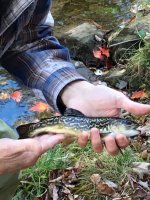RLeep2 wrote:
>>If you want wild tigers go to Wisconsin or Michigan. PA waters doesn’t fluctuate enough for them to make wild tigers it would be really tough for the extra chromosomes. >>
I'm not sure what the "fluctuate" part of this means, but I'd agree at least for a given window in time, I ran into more wild tigers in Wisconsin than I ever did in PA.
During a 4-5 year period when Wisconsin was deliberately trying to establish (or re-establish..) brook trout in some of their pretty high abundance brown trout streams through the use of feral brook trout fingerlings, I caught 3 or maybe it was 4 tigers that based on size (all under 9"), appearance and stream setting, I was pretty sure were wild.
In a lot of years tramping small stream in NW and NC Pa., I got one. This was in a small stream in the Loyalsock drainage. It was maybe 6 1/2 inches.
I know barely enough about how this stuff works to even have an opinion, but I'd think that as a matter of common sense, there would be a better chance for a wild tiger in streams with pretty robust but balanced populations of both brooks and browns. This, I'd think would at the least increase the chances of the cross occurring in the wild, etc.
And it may be that one (of perhaps many..) reasons why tigers are so rare in the wild is the natural tendency of one species to dominate in a given stream section or setting. This too would make sense to me as it would lower the odds of a successful cross or natural accident..





